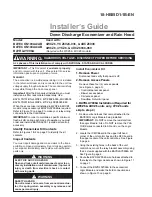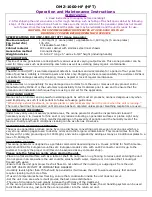
15
Note:
Ensure that the wiring is not pinched when fitting the terminal box cover.
Pinching the wiring may cut it.
Caution:
Install wiring so that it is not tight and under tension. Wiring under tension
may break, or overheat and burn.
•
Fix power source wiring to control box by using buffer bushing for tensile force.
(PG connection or the like.) Connect transmission wiring to transmission terminal
block through the knockout hole of control box using ordinary bushing.
•
After wiring is complete, make sure again that there is no slack on the
connections, and attach the cover onto the control box in the reverse order
removal.
9.3. Connecting electrical connections
Please identify the model name of the operation manual attached on the terminal
box cover with that shown on the rating name plate.
1. Remove the screw (1pc) holding the cover to dismount the cover.
[Fig. 9.3.1] (P.6)
A
Screw holding cover (1pc)
B
Cover
2. Open knockout holes
(Recommend to use a screwdriver or the like for this work.)
[Fig. 9.3.2] (P.6)
C
Terminal box
D
Knockout hole
E
Remove
Caution:
Install wiring so that it is not tight and under tension. Wiring under tension
may break, or overheat and burn.
3.
Fix power source wiring to terminal box by using buffer bushing for tensile force.
(PG connection or the like.) Connect transmission wiring to transmission terminal
block through the knockout hole of terminal box using ordinary bushing.
[Fig. 9.3.3] (P.6)
F
Use PG bushing to keep the weight of the cable and external force from being applied
to the power supply terminal connector. Use a cable tie to secure the cable.
G
Power source wiring
H
Use ordinary bushing
I
Transmission wiring
J
Conduit
K
Side frame
L
Knockout hole (for power source wiring)
M
Washer (round) (accessory)
4. Connect the power source, Earth, transmission and remote controller wiring. The
dismounting of the terminal box is not needed.
[Fig. 9.3.4] (P.6)
N
Terminal block for power source
O
Terminal block for indoor transmission
P
Terminal block for remote controller
[Shield wire connection]
[Fig. 9.3.5] (P.6)
A
Terminal block
B
Round terminal
C
Shield wire
D
The earth wire from two cables is connected together to the S terminal. (Dead-end
connection)
E
Insulation tape (To keep the earth wire of the shielded cable from coming in contact
with the transmission terminal)
5. After wiring is complete, make sure again that there is no slack on the
connections, and attach the cover onto the terminal box in the reverse order of
removal.
Caution:
Wire the power supply so that no tension is imparted. Otherwise
disconnection, heating or fire result.
Notes:
• Do not pinch the cables or wires when attaching the terminal box cover.
Doing so may cause a risk of disconnection.
• When accommodating the terminal box, make sure that the connectors on
the box side are not removed. If removed, it cannot operate normally.
9.4.
External I/O specifications
Caution:
1. Wiring should be covered by insulation tube with supplementary insulation.
2.
Use relays or switches with IEC or equivalent standard.
3. The electric strength between accessible parts and control circuit should
have 2750 V or more.
9.5. Selecting the external static pressure
Five levels of external static pressure are available for selection.
Set the setting either by using the switches on the control board (SW21-1, SW21-2, and SW21-5) or from the function selection screen on the remote controller.
[Fig. 9.5.1] (P.6)
<Indoor controller board>
Notes:
• When the static pressure setting was set from the remote controller, the actual setting and the switch setting on the control board may not match because the
latest setting from the remote controller overrides the previous setting. To check the latest static pressure setting, check it on the remote controller, not on the
switch.
• If the static pressure setting for the duct is lower than that for the unit, the fan of the unit may repeat start/stop, and the outdoor unit may remain in a stopped
state. Match the static pressure settings for the unit to that for the duct.
►
To set the external static pressure with the switches on the control board
External static pressure
SW21-1
SW21-2
SW21-5
Initial setting
0.14 in. WG
(35 Pa)
OFF
OFF
OFF
0.20 in. WG
(50 Pa)
ON
OFF
OFF
○
0.28 in. WG
(70 Pa)
OFF
ON
ON
0.4 in. WG
(100 Pa)
OFF
OFF
ON
0.60 in. WG
(150 Pa)
ON
OFF
ON
















































